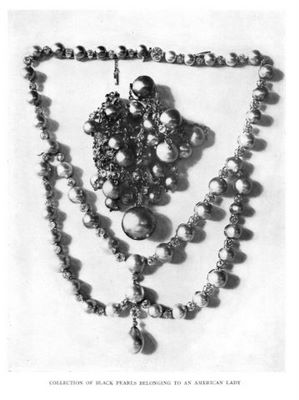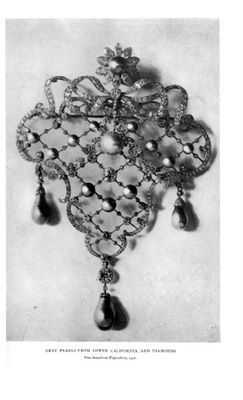|
Black Pearl HistoryBlack Pearl History -- Made Popular by Empress Eugenie
Some of the information on this page is from experts at the beginning of the twentieth century. Keep that in mind when reading as some facts mentioned may no longer be factual in today's pearling world.
About 1845, pearls came on the market from the Tuamotu Archipelago and other South Sea islands, and the industry was revived on the Mexican coast. The pearls from these localities are noted for their range of coloration, and particularly for the very dark shades, black or greenish black being especially prominent.
But the fashion, and thus, necessarily, the demand, had always been for white and yellow pearls; consequently, these black ones were of little value in the markets until about ten years later, when they became fashionable in Europe largely through their popularity with Empress Eugenie of France, then at the height of her power. To this queen, black pearl history owes much of their high rank in fashion in the nineteenth century; and on her head they were royal gems royally worn, as appears from Winterhalter's portrait of her, showing her magnificent necklace.  Black Pearls Black Pearl History -- Coloration
The color of pearls has no connection with the luster. In general it is the same as that of the shell in which they are formed. Black pearls are found in the black shells of Mexico, and pink pearls in the pink-hued Strombus of the Bahamas. Ceylon pearls are seldom of any other color than white, and Sharks Bays are almost invariably quite yellow or straw-colored, while those of Venezuela are commonly yellowish tinged. But from other localities, pearls simulate every tint of the rainbow, as well as white and black. They may also be piebald--a portion white and the rest pink or brown or black. Some years ago there was on the market a large bean-shaped pearl of great luster, one half of which was white and the other quite black, the dividing-line being sharply defined in the plane of the greatest circumference.
The pearls from Mexico, the South Sea islands, and the American rivers are especially noted for their great variety of coloration, covering every known tint and shade, and requiring such a master as Theophile Gautier to do justice to them. Black Pearl History -- Coloration Theories
Many theories have been advanced to explain the coloration of pearls. When the old idea of dew formation prevailed, it was considered that white pearls were formed in fair weather, and the dark ones when the weather was cloudy. It was further considered that the color was influenced by the depth of the water in which they grew; that in deep water they were white, but where it was so shallow that the sunlight easily penetrated, the pearls were more likely to be dark in color. Tavernier curiously explained that the black pearls of Panama and Mexico owed their color to the black mud in which the pearl-oysters of those localities lived, and that Persian Gulf pearls were more inclined to yellow than those of Ceylon, owing to the greater petrifaction of the flesh before they were removed. Two centuries ago the color of a pearl was attributed to that of the central nucleus, and it was concluded that if the nucleum was dark, the pearl would be of a similar hue. This theory in black pearl history has also been upset, for pearls are found white on the exterior and quite dark within, and also with these conditions reversed. The color of pearl is determined by that of the conchiolin, as appears from its remaining unchanged after decalcification. While generally it is the same as tht of the mother-of-pearl at the corresponding point of the shell in which it is formed, there are many exceptions to this, and the reasons for the varying tints and colors are probably to be found in the changes in position of the pearl, the ingredients of the water, the health of the mollusk, accidents of various kinds, etc.  Gray Pearls Black Pearl History -- Mexican PearlsPearl-bearing oysters are found at various places on the Pacific coast of Mexico, and especially along the coast of Lower California, where extensive fisheries used to be. The pearls are noted for the great variety of colors which they display. A large percentage are black, others are white, brown, peacock green, etc. Generally they are small and of irregular form, yet sometimes very large ones are secured, weighing 100, 200, and even 300 grains. European knowledge of black pearl history and of the pearl resources of Mexico dates from the conquest of that country by Hernando Cortes about 1522. The diary of his lieutenant, Fortuno Ximines, tells of finding native chiefs living in primitive huts along the sea-shore, with quantities of beautiful pearls lying carelessly around. From a tribe near the site of Hermosillo, in the State of Sonora, Cortes secured great quantities of the gems. It appears from black pearl history that the fishery had been in existence for centuries. The location of the pearl reefs was prominently noted on Cortes' map of this coast, made in 1535, a copy of which was procured by the Rev. Edward E. Hale when in Spain in 1883.
Black Pearl History -- Faded Russian PearlAnd interesting story in black pearl history takes place in 1884, when Mr. Edwin Streeter was asked by a member of a London syndicate to proceed to the East, to value a large quantity of jewels, as a heavy sum of money was about to be advanced in a certain Power, to provide the sinews of war. On his way he was requested to stop at one of the principal towns in Germany to purchase some jewels which had been valued for probate but were not easy of sale in that market.
The valuation paper was shown to him, and after examining the ornaments, he agreed to take them at the prices named. Among them was an old gold brooch of Russian manufacture, valued at £4; in the center of this brooch was what appeared to be a piece of hematite, but was in reality a fine, round, black pearl, weighing 77 grains. The color had faded from exposure to the sun. This pearl was brought to London, and the outer layer was taken off, when a perfect black pearl of 67 grains was uncovered. This was sold to a manufacturing jeweler in London for £400; but, having heard that in Paris there was a pearl that would exactly match it, Mr. Streeter bought it back again for £600, and then sold it at a large profit to one of the Paris crown jewelers, who, in his turn, sold the pair to a rich iron merchant for 50,000 francs (£2,000 or $10,000). Since then the sum of 100,000 francs (£4,000 or $20,000) has been refused for this pair of matchless black pearls.
Black Pearl History -- Not Regarded by AncientsBlack pearl history shows they did not seem to have been regarded with any favor by the ancients, and we find no mention of them by medieval writers. In 1850 a perfectly round, black pearl, weighing 8 grains, was sold for £100 ($500). Empress Eugenie, the wife of Napoleon III, may be said to have brought them into favor; she owned a splendid necklace of black pearls which was sold at Christie's after the fall of Napoleon, for the sum of £4,000 ($20,000). Some time later, the Marquis of Bath bought, at Christie's, the pearl which formed the clasp of the necklace, paying £1,000 ($5,000) for it; he destined it for the center of a bracelet. Greenish-black pearl are perhaps valued higher than any other colored pearls, if they have the proper orient; this is probably partly owing to their rarity. A bluish-black pearl possessing a fine orient commands almost the same price as a pure black pearl. Those which are found in the Placuna placenta are often of a dull gray hue, while those produced by the Pinna squamosa are generally brown in color.
Black Pearl History -- Restored by Peeling
Streeter mentions a very interesting incident in black pearl history in regard to a genuine black pearl. This pearl set with diamonds, was shown in a jeweler's window; but after exposure in this way for some time to the sun's rays, the brilliant black luster disappeared and gave place to a dull, grayish hue. When the pearl was removed from its setting, it was seen that the part which had not been exposed to the light was of as good color as when first removed from the shell. It was finally determined to skin off the outer layer, an operation which was performed with so much success that the original brilliant black hue was fully restored, proving that the action of the sunlight had only changed the color of the surface. The pearl, although it was shown in the sun, may never have had a good "skin" or layer exposed; or the layer which was not perfect may have been affected by an exudation of the wearer produced by illness or medicine. A curious bit of black pearl history is connected with a beautiful black pearl which was at one time in the possession of Count Louis Batthyani, the premier of the revolutionary government of Hungary. The count was shot in 1849, by the orders of a court-martial, and on the eve of his execution he gave the pearl, which he had worn mounted ona scarf-pin, to this trusty and faithful valet. The latter left it to his son, who, when in straightened circumstances, sought to raise money upon the pearl. The pawnbroker of the small town was distrustful of its value and took it to Budapest for appraisal. There the suspicions of the authorities were aroused, an investigation was ordered, and it ws finally discovered that the pearl had been stolen one hundred and fifty years before form the English crown. The English government redeemed it for the sum of £2,500 ($12,500). How it came into the possession of Count Batthyani is a mystery in black pearl history; probably he purchased it from some antiquarian. Black Pearl History -- A Fine CollectionWhat is said to be the finest collection of black pearls in all Europe is that belonging to the Duchess of Anhalt Dessau, Germany. It consists of three large caskets of black pearls that have taken a century to collect. According to black pearl history, it was traditional in the family that these pearls are never to be sold except as their last possession, since they know they will always find a purchaser. Special thanks for this information from Kunz and Stevenson as recorded in 1908. Go to main black pearls page after black pearl history.
Free Newsletter all about Pearls!
|






